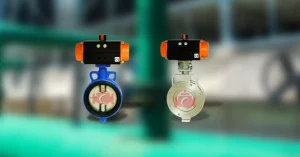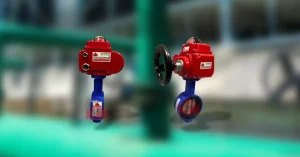Understanding the Working Principle of Pneumatic Butterfly Valves
Pneumatic Butterfly Valves are essential in a variety of industrial uses due to their effectiveness, accuracy as well as the ease of automating. When working with liquids gas, liquids, or dust, the valves provide an affordable, compact solution to control the flow of fluids within the piping system.
What exactly is pneumatic butterfly valves work? What is the reason they are a common option for engineers from all industries? Today, we’ll explore the mechanisms, structure as well as the benefits and application of pneumatic butterfly valves and the insights of Concorde Valves and Automations Experts in the field of industrial automation.
If you’re an engineer seeking to expand your knowledge or someone considering pneumatic butterfly valves for your next project, this guide is for you.
Introduction to Pneumatic Butterfly Valves
The Pneumatic Butterfly Valve is equipped with an elongated disc that is its primary control element coupled with the accuracy of the pneumatic actuator. The actuator allows the valve to shut off as well as open and modulate airflow using compressed air for its energy source. This allows pneumatic butterfly valves highly robust and suitable for speedy processes, without the need for manually operated intervention.
Contrary to manual valves of the past butterfly valve with pneumatic actuators is ideal for businesses which require precise remote control as well as low-maintenance equipment.
Starting with uPVC butterfly valves to light-weight applications, to high-pressure versions to industrial pipelines, you can find the “pneumatic butterfly valve” tailored to meet the needs of every task.
Components and Structure Explained
Knowing the structure of an air-operated butterfly valve is crucial in understanding its principle of operation. The following are the principal elements that are typically present within the pneumatic operated butterfly valve:
- Valve Body This is the exterior body that houses the internal parts. Available in various materials including stainless steel PVC and uPVC to suit various applications.
- Butterfly disc: A circular piece of metal inside the valve that turns to regulate the flow of fluid.
- Seat/Seal Constructed out of elastomer, or similar materials to stop leaks while the valve is closed position.
- Stem, or Shaft The shaft connects the butterfly disc with the actuator to provide motion in the rotation.
- Pneumatic Actuator: The power behind the valve pneumatic butterfly valve actuator utilizes compressed air to produce tension that allows the disc to open or shutting of disc.
- Control System It is optional, yet highly effective, technologies such as positioners or solenoid valves typically are integrated to provide better control.
Working Principle of a Pneumatic Butterfly Valve
This working principle of a butterfly valve with pneumatic actuator can be broken down into easy steps:
1. Actuation
The compressed air is supplied to the pneumatic actuator. It is determined by the type that the device operates (single-acting and double-acting) the air pressure is used to move a diaphragm or an axis rack to produce torque.
2. Disc Rotation
The torque generated is transmitted via the shaft in order to spin the disc of the butterfly inside the valve’s body. In general, a 90 degree rotation is enough to open or shut the valve.
3. Flow Control
- Fully In Open Position The disc spins in a parallel direction to flow to allow maximum flow throughout the valve.
- Partially open Position To throttle applications an actuator may modify the disc into an intermediate location for controlled flow.
- Fully Completely Closed Position This disc turns parallel to the flow, sealing the flow that cuts off flow completely.
The rapid and precise motion creates pneumatic actuated butterfly valves the ideal choice for those who require rapid, high-speed operation.
Advantages and Disadvantages
Advantages
- Small Design It is light and simple to set up compared to different valve designs.
- Cost Efficiency Cost-effective initial costs, and minimal maintenance needs.
- Automatically-Friendly The integration with devices such as” butterfly actuator valve butterfly actuator valve enhances the accuracy and capacity.
- Large Material Variety: From stainless steel up to uPVC butterfly valves, they serve a wide range of industries.
- Rapid Operation compressed air allows for fast closure and opening.
Disadvantages
- Pressure Limitations It is not appropriate for applications with extremely high pressures.
- The possibility of wear: The disc could wear out over time usage, especially when used within abrasive fluid systems.
Applications in Various Industries
Pneumatic butterfly valves are used in a wide use due to their flexibility and effectiveness. A few industries in which actuated butterfly valves are a highlight are:
- Oil & Gas: For flow isolation within pipelines.
- water treatment The use for uPVC butterfly valves to perform light, durable and corrosion-proof operations.
- Food and Beverage Operation that is safe and clean thanks to the valve material’s non-corrosive characteristics.
- Chemical Processing Accuracy in dealing with chemicals that are aggressive.
- HVAC systems: To control gas and air flow within ventilators.
Maintenance Tips and Best Practices
For ensuring the longevity that you have installed in the long-term performance of your pneumatic actuator butterfly valve Follow these tips for maintenance:
- Regular inspections: Check the disc and the seat for corrosion or wear.
- Lubrication Make sure that the shaft and the components of actuators properly lubricated.
- Air Quality of Supply: Use clean dry, dry air in order to avoid obstruction of the actuator.
- Seal replacement Replace and monitor gaskets or seals to keep the leak-proof function.
- Calibration The actuator should be calibrated on a regular basis to ensure accuracy performance.
A trusted supplier such as Concorde Valves and Automations reduces the need for maintenance and assures durable components that are high-performance.
Future Trends and Innovations
The realm of pneumatic butterfly valves is changing with the advent of trends like Industry 4.0 and IoT integration. The valves are now able to diagnose themselves and communicate real-time performance data, dramatically increasing performance and speeding up time to repair.
Another new development in the works is energy efficient actuators that reduce the use of air which can reduce operating costs but ensuring speed and precision.
Explore High-Quality Pneumatic Butterfly Valves
The integration of an butterfly valve with pneumatic actuator to your system will enhance operational efficiency, ensuring the ability to scale and also reliability. As technology advances and improvements in materials, automated systems the valves are set to continue to be the top option for engineers.
If you’re in search of top-quality products, Concorde Valves and Automations provides a variety of pneumatic operated butterfly valves that are designed to satisfy modern industry demands. Check out our site or talk to a specialist today for help in determining the best valve to meet your requirements.





